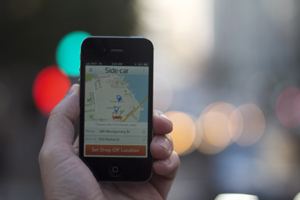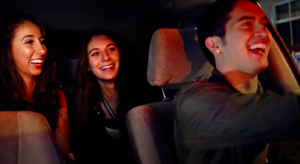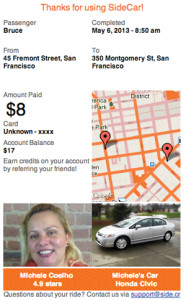New Sidecar Smartphone App Sends Traditional Ride Sharing Skidding Sideways
I may never ride another taxi again. We’ve all experienced it. Gone are the days of the jovial Cabbie, “So where are you folks from?” Eager to welcome visitors to his city, or enthusiastically pointing out the best the city has to offer. Extinct: Apparently any conversation whatsoever, now replaced by a white-knuckle death race with a seemingly angry person at the wheel. Nothing against angry people who drive cabs, this has just consistently been my own experience.
Enter SideCar: The ride sharing app for your smartphone that is about to change all of that. 
Imagine this—you tap an app, choose your pickup location like you would choose any point on Google maps. Then you choose your destination. Then you tap the button to request a ride. Next, imagine the app confirms your ride and informs you that “Michelle” will be there in her neat and tidy silver Honda Civic in six minutes.
Well stop imagining it, because that is exactly how the SideCar app works.
To test it out for this article I signed up for the service with the usual login password or using one of my social media logins, accompanied by a credit card to pay with. In fact a “Michelle” picked me up in her neat and tidy silver Honda Civic, and we had a great conversation as she calmly and accurately navigated our way through the busy morning traffic of San Francisco on a beautiful warm day.
Yes! We actually chatted!
The Valhallan promise of Social Media applications had always been that it would lead to real social interactions and real friendships. The problem seems to have been getting out of the house. SideCar may have unintentionally solved this dilemma, because with SideCar, after you submit a new friend request, six minutes later he/she’s waiting for you, outside your door! How cool is that? Ok so I may be overstating all of this a bit, but not much. And it certainly doesn’t feel like that didn’t happen in my ride with Michelle.
But here’s how it really works. SideCar is one of the new Ride Sharing models being explored in the app-sphere these days. You’ve heard about it, no doubt. Ride sharing is different than car sharing however, and possibly cooler, depending on what you consider “cool.” Having tried both, I now know what I prefer.
Car sharing, like those white with the wild blue stripes, Car-2-Go Smart cars (a Mercedes venture), or the nondescript Zip-Cars (recently bought out by Hertz) are large company-backed fleets of vehicles bought with the express purpose of sitting around doing mostly nothing, waiting for someone to rent one. I know, where’s the Green in that? Don’t answer that; it’s a loaded. rhetorical question.
Ride Sharing is different. There is no fleet, so no buying yet more cars to put on (or park on the side of) the road. Using existing cars with qualified and hand picked drivers, Ride Sharing networks all of it with riders looking for rides to share. As the rider, you can use SideCar by yourself or as a group. You pay the same suggested fare. I can think of using SideCar as an ideal solution for carpools.
Other players in this space, Lyft and Über, do pretty much the same thing, but I think SideCar simply does it better. It could be the app, because the simple beauty of the thing and its great design, portend a lot more that is obviously happening underneath.
SideCar is that perennial “San Francisco startup cliche.” You’ve seen it in numerous films by now. A couple of big rooms, and a roof garden, taking over the top three floors of a small brick building on Pine street, a giant faded poster of “Attack of the 50 Foot Woman” on the back wall, a couch-lounge in the center, large shared tables lined with developers, writers, social media marketers, head-phoned heads bobbing, group collaborating. No suits, no ties, no cubicles, no plastic, no MadMen—this is how it’s done these days.
SideCar started in San Francisco in March 2012, and now covers 10 major cities in the US and is expanding.
Besides developing a great Rider app, most of the effort actually goes into managing the drivers who get their own Driver app, and are carefully screened and selected to properly present the exact SideCar experience. SideCar focuses on care and attention to detail, and while all of that sounds obvious, it is what most others miss.
Drivers with a four door car (I know, I was hoping for a convertible too) apply to become a SideCar driver, and after a background check and insurance, and other points of qualification, are invited to attend a real instructor-led SideCar University, where they actually meet face to face with a SideCar “Community Manager” (no, seriously). They are then coached, groomed and trained on how to provide the very best service and experience to the riders.
When I say Community, I mean exactly that. Drivers in each metro are added to a Facebook group where the SideCar community managers can stay in touch with them, hold regular discussions, and the drivers can share feedback and make suggestions to help make the service better. Like recommending the best mechanic, finding the cheapest gas station, or suggesting hot spots or, more importantly, places to avoid. They even meet for real get-togethers. Almost makes you want to become a SideCar driver!
As a rider, the experience is nothing short of luxurious, without the guilt. There is something both socially and environmentally responsible about knowing you are using existing resources in a mutually beneficial way. And it’s far cheaper!
SideCar uses a proprietary algorithm that considers things like distance, the local price of gas, and even current traffic conditions to estimate a “Suggested Fare” which you can bump up or down at your discretion, get this, after you get off. You don’t pay the driver. SideCar does.
After a 20% fee off the top, the remaining 80% of what you felt your ride was worth, is deposited into the Driver’s account. The driver determines when to drop it into his bank from the, you guessed it, Driver app.
The Driver app is an even simpler app equally elegant as the Rider version, designed specifically to minimize driver interaction, for safety, and to make accepting and confirming pickups and bank transfers and a couple of other things, as minimal as possible. Again, for Safety. It’s one of those rare occasions in software development, where everything makes sense, and is so simple that it just works really well.
There well may be many obvious seemingly insurmountable obstacles yet to overcome before the SideCar promise of RideSharing can be fully achieved. How this new paradigm will fit into the City hall, Taxi Cab Concessions, Taxi Unions, public acceptance, and the whole sphere of how fare-based transportation used to work, is anyone’s guess at this time.
But in a day and age of hybrid and electric cars and solar panels on the verge of energy independence from fossil fuels, I’m not sure there is anymore room for a curbful of badly aging yellow cars, engines running, lined up, drivers slap tickling each other, waiting for passengers to merely walk by.
But like I said at the beginning, I may never ride another taxi again.
Leave a Reply